- Order-3 heptagonal tiling
-
Order-3 heptagonal tiling 
Poincaré disk model of the hyperbolic planeType Regular hyperbolic tiling Vertex figure 7.7.7 Schläfli symbol(s) {7,3} Wythoff symbol(s) 3 | 7 2 Coxeter-Dynkin(s) 




Coxeter group [7,3] Dual Order-7 triangular tiling Properties Vertex-transitive, edge-transitive, face-transitive In geometry, the order-3 heptagonal tiling is a regular tiling of the hyperbolic plane. It is represented by Schläfli symbol of {7,3}, having three regular heptagons around each vertex.
Contents
Images
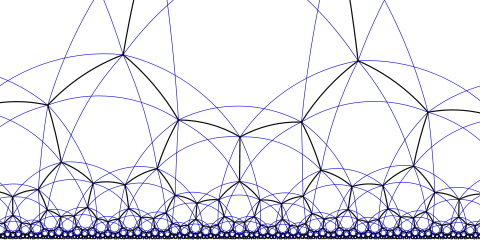
Heptagonal tiling (black lines) in a Poincaré half-plane modelRelated polyhedra and tilings
This tiling is topologically related as a part of sequence of regular polyhedra with Schläfli_symbol {n,3}.
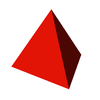
{3,3}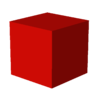
{4,3}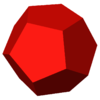
{5,3}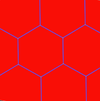
{6,3}
{7,3}
{8,3}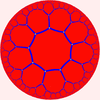
{9,3}
(∞,3}The dual tiling is the order-7 triangular tiling.

order-3 heptagonal tiling
order-7 triangular tilingWythoff constructions from heptagonal and triangular tilings
From a Wythoff construction there are eight hyperbolic uniform tilings that can be based from the regular heptagonal tiling.
Drawing the tiles colored as red on the original faces, yellow at the original vertices, and blue along the original edges, there are 8 forms.
Tiling Schläfli
symbolWythoff
symbolVertex
figureImage Order-3 heptagonal tiling t0{7,3} 3 | 7 2 73 
Order-3 truncated heptagonal tiling t0,1{7,3} 2 3 | 7 3.14.14 
Rectified order-3 heptagonal tiling
(Triheptagonal tiling)t1{7,3} 2 | 7 3 (3.7)2 
Bitruncated order-3 heptagonal tiling
(Order-7 truncated triangular tiling)t1,2{7,3} 2 7 | 3 7.6.6 
Order-7 triangular tiling t2{7,3} 7 | 3 2 37 
Cantellated order-3 heptagonal tiling
(Rhombitriheptagonal tiling)t0,2{7,3} 7 3 | 2 3.4.7.4 
Order-3 omnitruncated heptagonal tiling
(Truncated triheptagonal tiling)t0,1,2{7,3} 7 3 2 | 4.7.14 
Order-3 snub heptagonal tiling s{7,3} | 7 3 2 3.3.3.3.7 
Hurwitz surfaces
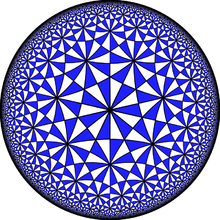 The symmetry group of the order-3 heptagonal tiling has fundamental domain the (2,3,7) Schwarz triangle, which yields this tiling.
The symmetry group of the order-3 heptagonal tiling has fundamental domain the (2,3,7) Schwarz triangle, which yields this tiling.
The symmetry group of the tiling is the (2,3,7) triangle group, and a fundamental domain for this action is the (2,3,7) Schwarz triangle. This is the smallest hyperbolic Schwarz triangle, and thus, by the proof of Hurwitz's automorphisms theorem, the tiling is the universal tiling that covers all Hurwitz surfaces (the Riemann surfaces with maximal symmetry group), giving them a tiling by hepatgons whose symmetry group equals their automorphism group as Riemann surfaces. The smallest Hurwitz surface is the Klein quartic (genus 3, automorphism group of order 168), and the induced tiling has 24 heptagons, meeting at 56 vertices.
The dual order-7 triangular tiling has the same symmetry group, and thus yields triangulations of Hurwitz surfaces.
References
- John H. Conway, Heidi Burgiel, Chaim Goodman-Strass, The Symmetries of Things 2008, ISBN 978-1-56881-220-5 (Chapter 19, The Hyperbolic Archimedean Tessellations)
- The Beauty of Geometry: Twelve Essays (1999), Dover Publications, LCCN 99-35678, ISBN 0-486-40919-8 (Chapter 10: Regular honeycombs in hyperbolic space)
See also
- Hexagonal tiling
- Tilings of regular polygons
- List of uniform planar tilings
- List of regular polytopes
External links
- Weisstein, Eric W., "Hyperbolic tiling" from MathWorld.
- Weisstein, Eric W., "Poincaré hyperbolic disk" from MathWorld.
- Hyperbolic and Spherical Tiling Gallery
- KaleidoTile 3: Educational software to create spherical, planar and hyperbolic tilings
- Hyperbolic Planar Tessellations, Don Hatch

This geometry-related article is a stub. You can help Wikipedia by expanding it.
